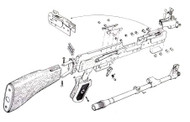Mechanics and workings inside the AK47: The technical parts and functions of the AK47 assault rifle
Posted by Mark A. Taylor - AK Nut on Dec 14th 2023
You are probably reading this blog because you agree with the statement that the AK47 is bad ass.But this specific post, you’re more likely probably reading to break down the technical aspects a bit deeper. So that being said, let's dive into it. Upon origination by Mikhail Kalashnikov in 1947, the AK47 utilized a reliable rotating bolt and gas piston operation paired with a high tolerance for dirt, sand, and lack of maintenance. This engineering allowed it to function reliably in adverse conditions on the battlefield.
At the core of the AK-47 is a gas-operated long stroke piston system. When a round is fired, propellant gasses are vented from the barrel into a cylinder that contains a piston. The force of this gas pushes the piston rearward, which causes the bolt carrier to move back, ejecting the spent casing and cocking the hammer. The spring then pushes the bolt carrier forward, stripping a new round from the magazine and pushing it into the chamber for firing. This self-regulating system helps enable reliable function despite dirt, debris or lack of cleaning.
The receiver of the AK-47, these days, is made from stamped and riveted sheet metal, making it faster and cheaper to mass produce than earlier milled receivers. The largely enclosed receiver helps prevent mud, sand and foreign objects from getting inside. The AK-47 utilizes a wide safety lever that can be manipulated quickly with a gloved hand. Controls are intentionally simplistic to aid operation under stress.
The AK-47 feeds from a 30 round curved detachable box magazine made of steel reinforced with wire. The magazine has feed lips that guide each round into the chamber. Polymer magazines are also available which are lighter but less durable. The AK-47 is chambered in 7.62x39mm, providing good stopping power and the ability to penetrate barriers.
The AK-47 has a 16.3 inch chrome lined barrel rifled with 4 right hand grooves. This provides accuracy while resisting wear and corrosion. The muzzle features slots that act as a compensator to reduce upward recoil. The front sight is adjustable up to 1000 meters for range. The rear sight is adjustable for windage and features a sliding notch for range adjustments.
The original AK-47 prototypes had machined, milled steel receivers. This involved cutting each receiver out of a solid block of steel using a milling machine. While very sturdy, this was time consuming and expensive to mass produce.
To reduce production time and costs, the design was changed to use stamped and riveted sheet metal receiver halves. Stamping the receiver from sheet metal is much faster and cheaper than milling from a solid block. However, stamped metal is generally less rigid than a milled part.
To account for this, the AK-47 receiver uses larger rivets and more of them - 10 in total - to join the two stamped halves together. Reinforcing ribs are also stamped into the metal for added stiffness. The front and rear trunnions, which hold the barrel, bolt carrier and buttstock, are made of heavier milled steel and riveted into place to handle the force of firing. Guide rails for the bolt carrier are pressed into the receiver and reinforced internally.
Despite being lighter weight, the stamped receiver is rugged and rigid enough to handle the pounding force of full auto fire. This manufacturing breakthrough allowed the AK-47 to be quickly mass produced by the millions with Soviet manufacturing capabilities at the time.
We must not neglect slings and pouches which are important accessories that enable the effective use and carrying of the AK-47 platform. Here are some more details on common sling and pouch configurations:
Slings:
- Original AK-47 slings were simple green canvas loops. Quick detach slings later became common.
- Modern tactical slings like the Vickers sling allow rapid shoulder transitions between strong and support sides.
- Single point slings attach at the rear of the receiver for mobility and vehicle carry (Rarely used with AK systems).
- Two point slings with adjustable lengths help customize carry position.
Magazine Pouches:
- AK-47 magazine pouches evolved from simple green canvas to modern polymer and MOLLE systems (Modular Lightweight Load-carrying Equipment).
- Chest rigs like the Chicom allow multiple magazine carriage for high readiness.
- Belt pouches in varying numbers hold spare magazines for sustained fire.
- MOLLE compatible AK pouches allow mixing and matching of gear.
- Backpack pouches such as ALICE system bags/pouches enable transport of multiple loaded magazines.
The AK-47's lightweight design and detachable magazines facilitated the use of pouches, rigs and slings for varied carrying and deployment. Proper sling techniques allow maintaining the weapon hands-free and rapidly shouldering for firing. Mag pouches evolved from makeshift canvas to specialized gear that extended the AK-47's combat utility. While the rifle's core was its rugged simplicity, accessories like slings and pouches expanded its capabilities in the field.
Needless to say, there are many variants and versions of the AK-47 produced globally, many different takes on accessories and components which when put together offer a glimpse into the unique cultural engineering needs and processes of each regions build(s) throughout history. However, despite all that, 75 years after the birth of the original AK the core design elements of reliability, simplicity and effectiveness that Kalashnikov engineered into his namesake rifle continue to make it one of the most ubiquitous firearms in the world. With many new adaptations and enhancements still yet to come.
If you liked that read check out the rad lesser known stories behind the original AK build and the region it was birthed!

